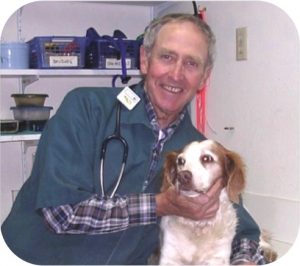Heart Disease in Geriatric Dogs
By William T. Testerman, DVM
Lub dub, lub, dub, lub dub, is the sound of a dog’s heart, as it contracts 70 to 120 beats a minute for its entire life. It is one of the first muscles to contract during development in the uterus and the last to quiver as life ends.
The heart is an amazing organ when we consider the work it does and how reliable it is. Its function, essentially, is to receive blood from the body, pump it into the lungs to pick up oxygen, then send it back out to the circulation system. Sounds pretty simple for such a complex, fist sized muscle. However, it is not an ordinary muscle but one with special cells that enable it to function efficiently and reliably throughout life, all under its own nervous system.
Even though the heart is very well constructed, it can show signs of disease, especially as the body ages. These can include irregular rhythms, weakening of the muscle wall resulting in the heart growing larger, narrowing of the major vessels flowing outward from the heart, infection of the lining and valves of the ventricles, and worms, spread by mosquitoes, that live in the heart. The most common problem to occur in older pets, however, is disease of the valves of the heart. Approximately 10% of all dogs will develop some form of heart disease during their life and 80% of those cases will be valvular disease.
Valvular disease in dogs, also referred to as valvular insufficiency, most commonly affects the valves of the left side of the heart. Some causes are related to the aging process as the valves are continually exposed to the high pressure created by the contraction of the heart muscle. Infection can also cause scarring and contraction of the valves. The main function of the valves is to control the blood flow in and out of the heart and when they are weak and do not close properly, there is leaking of blood between the chambers. This leaking causes a fuzzy sound and the familiar lub dub sound is replaced by a murmur which can be heard by using a stethoscope over the heart.
One of the first signs of heart disease that the owner may notice is a soft cough, especially at night as small amounts of fluid leak into the lung spaces due to a slowing of the blood through the vessels. As the condition develops, the coughing becomes worse and the animal appears weak. Many other organs of the body are affected as the disease progresses. The kidneys and liver do not receive enough blood supply and undergo degeneration and fluid starts to accumulate in the lungs, abdomen and skin.
There are several tests that can provide information as to the severity of the heart problem. These include the use of the stethoscope by the veterinarian to identify murmurs and their intensity, chest x-rays, blood tests, electrocardiogram, and ultrasound. Of all the tests, the ultrasound provides the most accurate determination of the heart’s pumping efficiency.
In humans, leaky heart valves can be replaced but that is usually not feasible in dogs. Drugs are the mainstay treatment of heart disease to prolong the life of affected animals. The two main drugs used are diuretics and angiotensin converting enzyme inhibitors or ACE-inhibitors. Diuretics help by stimulating the kidneys to remove excess fluid from the body there- by reducing the workload on the heart and other organs. The ACE-inhibitors are very effective in lowering the blood pressure and reducing the resistance of blood flowing from the heart. Digitalis is also used to slow the heart rate and to strengthen the contractions of the muscle. A low salt diet can help by preventing the retention of excess fluid.
Early detection and the use of drugs, when needed, can prolong the life of a dog with heart disease. How long depends on the response to the medication and the recovery of organs that may have been damaged. Most affected dogs do well on treatment and can live for many months or even years after diagnosis.
About Dr. Testerman: After a brief stint in the Army Veterinary Corps, two years in the Peace Corps in Peru, and three years in a mixed practice in Tennessee, Washington became home for Dr. Testerman. Following eight years in a dairy/small animal practice in Sedro Woolley, and another two years of voluntary veterinary work in Bolivia, Anacortes became the final place for Dr. Testerman to practice in a small animal clinic and for him and his wife, Ann, to raise their three daughters. “After almost 40 years of veterinary work, the challenges of working with animals is still enjoyable. Although presently retired, relief work keeps me busy and up on the latest innovations.”


